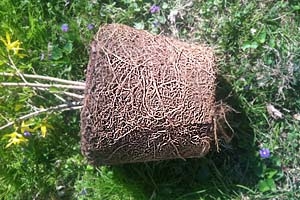Getting A Lasting Good Buy
A smart gardener’s guide to choosing plants
by Marsha Goldberg, Fairfax Master Gardener
It’s that time of year when people can hardly wait to get to the garden center, nursery, or big box store to buy annuals and perennials. There are methods you can use to be sure that you are buying a healthy plant that will thrive in your garden, whether just for this year or for years to come.
For starters, beware the big, beautiful plant, heavy with colorful blooms that seems perfect to fill that empty spot in your bed. This is not the plant you want to buy. Instead, look for a compact bush or plant that has many stems and is not yet in bloom. Growers often force plants into bloom by using excess fertilizer or by raising them in an environment that encourages early growth. As a consequence, the root system may not have had enough time or enough nutrients to develop adequately to support long-term growth.

Root-bound forsythia — best to leave this one at the garden center
With a little investigative work, you can determine the roots’ condition. Don’t be shy. Give the pot a gentle squeeze or tap, turn it over, and let the plant slide out, allowing you to see its root system. You should be able to see nicely-sized, fleshy white roots throughout the soil. Roots should “grab” and hold on to the soil. If the soil falls away from the root system when you take the plant out, the root system may be too small to support a healthy plant. On the other hand, avoid root-bound plants. These are the ones that have roots that are tangled and matted, and are often circling around the bottom of the plant or shooting out of the container’s drainage holes. Root-bound plants have been trapped in their pots too long, which may result in stunted growth or even death once you get them in your garden.
Next, look at the leaves. Avoid plants that are wilted or yellow, as this can be caused by a number of diseases. Plants should be bright or dark green unless you know that the specific cultivar you are buying has leaves in the light green to yellow range. Look at the other plants on the table as well to see if any look compromised. The plant you are holding may appear to be healthy, but plant diseases can spread quickly, especially when plants are in close proximity. A neighboring plant that is sick or under attack may be infected, too, but not yet showing any signs. Be sure to check both sides of the leaves for any evidence of bugs or fungus. Look for bugs that you can see, but also look for signs that bugs or diseases leave. These signs include holes in the leaves; spots that are brown, black, or yellow; circular shaped markings; or white fuzz. Steer clear of plants with these issues.
If you garden a lot or expect to buy a lot of plants, you might want to invest in an inexpensive magnifying glass to help you spot problems that may not be visible to the naked eye. Spider mites, for example, are tiny and usually cannot be seen by looking at the leaves but are visible with a magnifying glass. You can buy an inexpensive one at a hobby shop, a toy store, or a hardware store.
Taking a close look at annuals, perennials, or shrubs before you buy will help ensure that you are starting with strong, green plants. After that, you and Mother Nature need to keep them that way.